I think tree roses can have one of the biggest impacts on a floral garden. They stand out among the other plants because of their unique shape combined with their colorful blossoms.
They’re also a challenge to grow. They need regular pruning, staking, and special care to keep them looking their best.
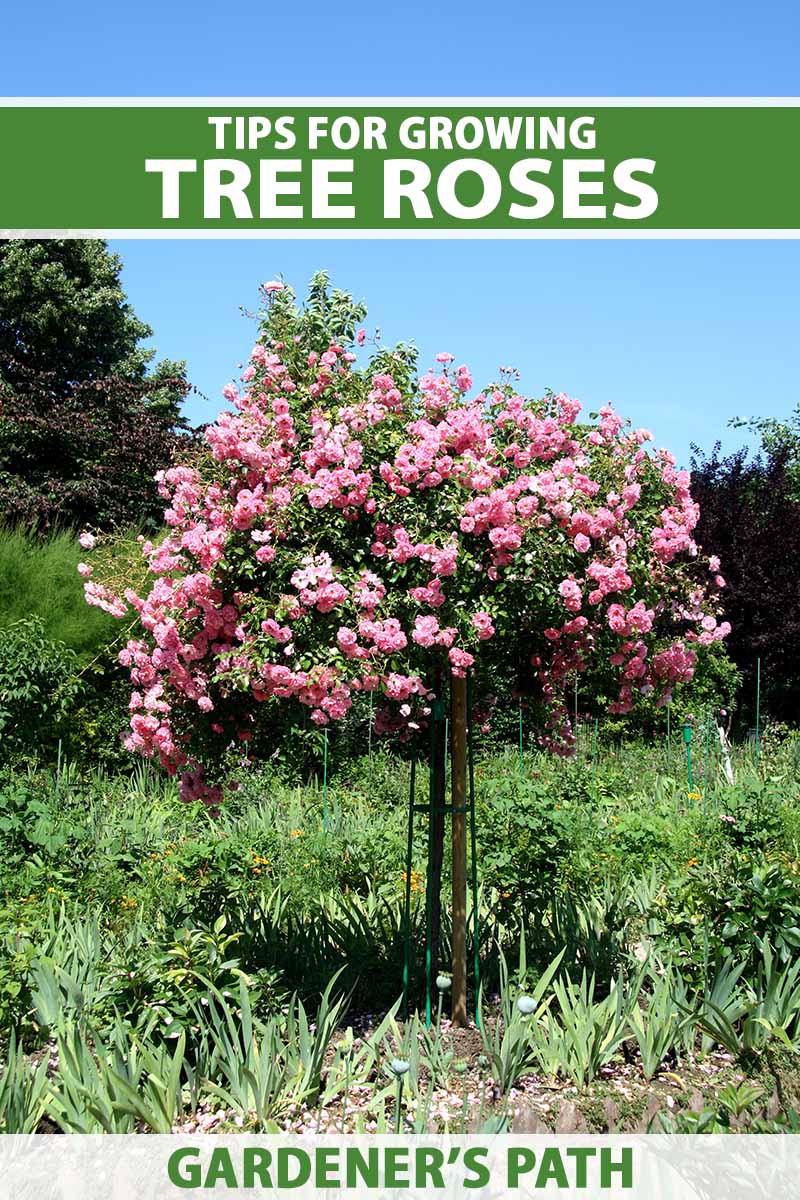
We link to vendors to help you find relevant products. If you buy from one of our links, we may earn a commission.
And as impressive as they can be when well cared for, there’s nothing that detracts from a garden display more readily than a sad, tilted, misshapen specimen.
This guide will help you make your tree rose into the crown jewel of your garden, rather than an eyesore.
Here’s what you’ll learn in the upcoming guide:
What You’ll Learn
No doubt you’re excited to jump in, so let’s go!
What Is a Tree Rose?
Tree roses, or standards, are roses that have been trained or grafted to have a long main stem with a bushy crown of peduncles, foliage, and blossoms.
They resemble tiny little trees, which is where the name comes from, of course.
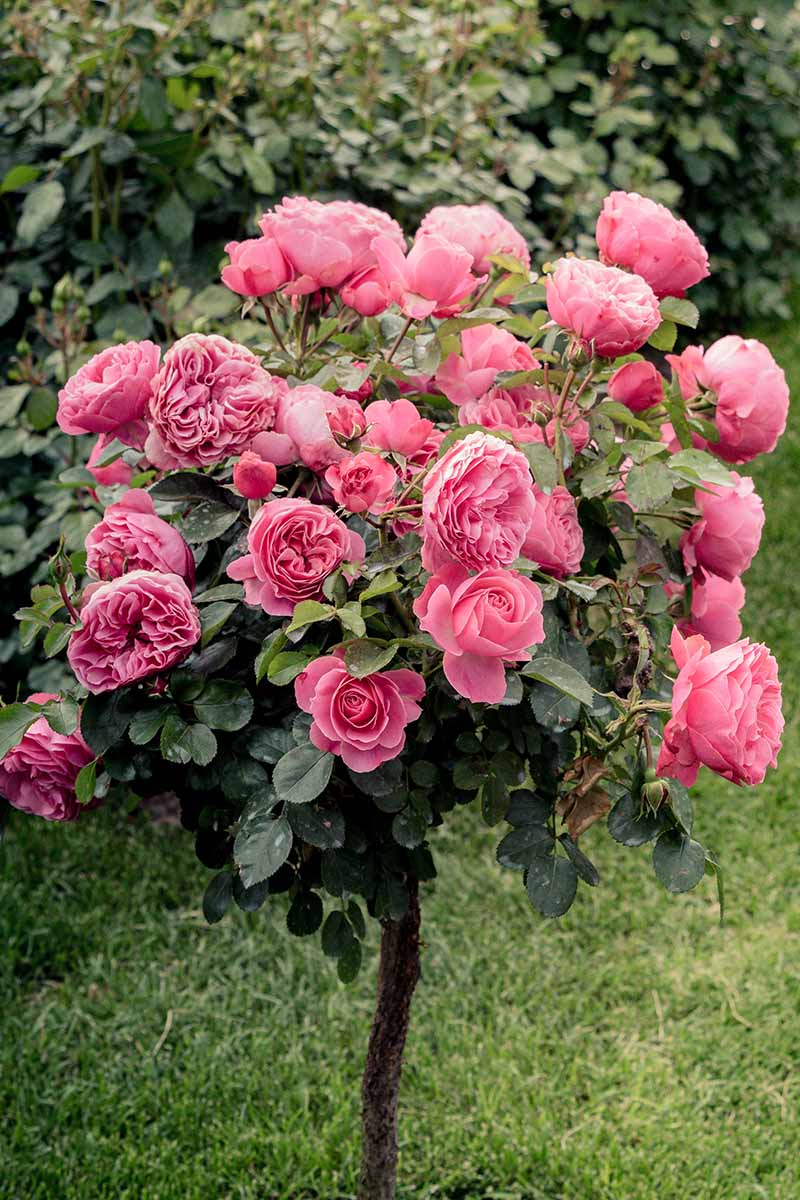
But botanically speaking, they aren’t trees. They’re just bushes trained into a shape they wouldn’t grow in naturally. They can range in height from a foot or two tall to up to eight feet. Smaller plants are often called patio tree roses.
They first became popular in the West in the 1800s.
To establish its tree shape, growers take a dormant rootstock and graft it onto a dormant stem. Then, they graft the desired top plant (scion), which is also dormant, onto the top of the stem.
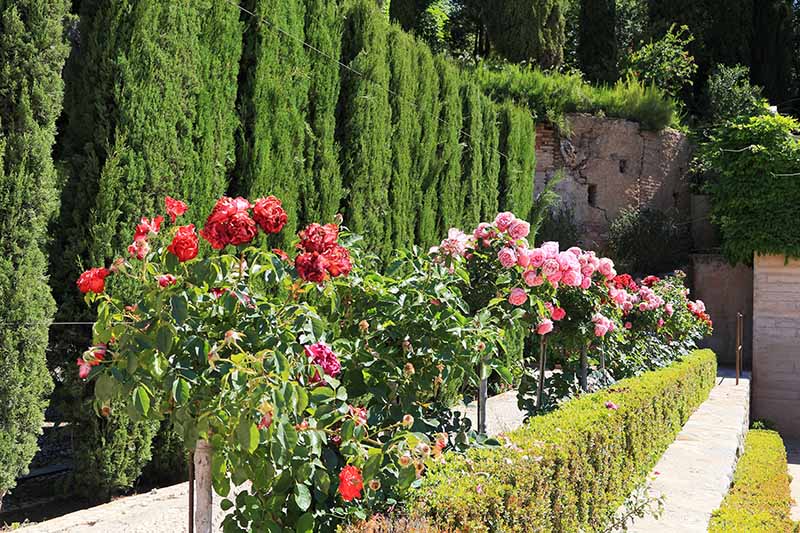
The rootstock and stem can be different species or types, but they are often the same. The scion is almost always a different type than the rootstock and stem.
Tree roses aren’t all from a certain category or species, but rather, this is just a description of their form. Any Rosa type can be made into a tree, but some lend themselves better to the process than others.
‘Dr. Huey’ is one of the most common rootstocks, but ‘Manetti,’ dog roses (R. canina), wild species types, or a hardy R. multiflora are also commonly used.
Stems are usually taken from multiflora or R. canina.
The tops are often hybrid tea, grandiflora, or floribundas, but you may see others. Not sure what the difference is between all these categories? You might want to read our guide to rose classification for a quick primer.
What makes ‘Dr. Huey’ so special? I’m sure you’re wondering. Well, ‘Dr. Huey’ is a hybrid wichurana climber or rambler that has incredibly robust roots. That means a sturdier base and quick growth for tree rose breeders.
We’ll talk about the downsides to this particular plant in just a minute.
Tree roses can be trimmed into tidy topiary shapes or left to be a bit more natural. I’ve seen topiary types trained to have one main head, known as a standard, or three balls tiered along the stem, sometimes called a ball trio.
They can also have a weeping or semi-weeping form. These typically use climbing or groundcover types as the scion.
If you are buying a tree rose, rather than pruning one yourself, it is almost always in standard form.
When commercial growers make standards, the process usually takes about five years from start to finish before the plants hit the market.
For the first two years, the roots, stems, and scion are typically grown separately. Then, in the spring or summer of the third year, the plant is grafted together. Many growers bud two scions onto the stem to create a bushier, fuller top.
The plant is grown for another year before being dug up while dormant, and sold as a bare root plant, or potted and sent to market.
Growing
When it comes to planting, watering, and fertilizing, you can basically treat standards as you would any shrub rose.
When choosing a growing spot, plant them where they won’t be hit with frequent or heavy winds. They’ll blow over easily or they might even break.

Plant at the same depth they were growing in the container. For bare roots, plant them with the lower bud union positioned just above the soil except in Zones 7 or below, where you should sink the bud union an inch or two below the soil.
You can learn more about how to plant bare root roses in our guide.
After planting, there are a few things you’ll need to do to keep your plant happy.
For plants with heavy heads or those that are weeping, keep the head pruned back by half in the winter for the first few years to encourage the stem to grow. After they finish blooming, prune them back slightly.
You also must stake standards if you want them to stay upright. No exceptions.
Sink a piece of rebar or metal pipe at least a foot into the ground next to the standard and extend it at least a few inches above the top graft union, ideally into the bushy head. If you don’t do this, your plant WILL tilt or fall over.
You can slide a bit of green garden hose over the metal to camouflage it a bit and to provide the bark with some protection against the metal.
Secure the stake to the stem using a flexible material. If you wear nylons, they’re perfect to cut up and used as a fastener. You can also buy nylon or rubber ties, or use leather. Check the straps frequently for signs of deterioration, breaking, or constriction around the stem.
You’ll see that some people recommend bamboo or plastic stakes.
I’m here to say: don’t do it! You need something extremely solid and sturdy like metal or a thick piece of hardwood. Wood stakes will need to be replaced every few years, though treated wood can last a bit longer.
As your tree grows, you might need to increase the height of the stake.
Now that I’ve drilled the importance of staking into your head, there is one exception worth mentioning. If you have selected plants that stay under a few feet tall when mature and have wild rose scions, you have the option of removing the stake after a few years.
Just keep an eye on them and be ready to replace the stake if things start to look a little tipsy. You may want to provide some winter support if you receive heavy snow, or at least gently shake off the snow after it lands.
Pruning
One of your biggest jobs is going to be pruning. Not only do you need to maintain the shape of the plant, but you also have to keep an eye out for suckers.
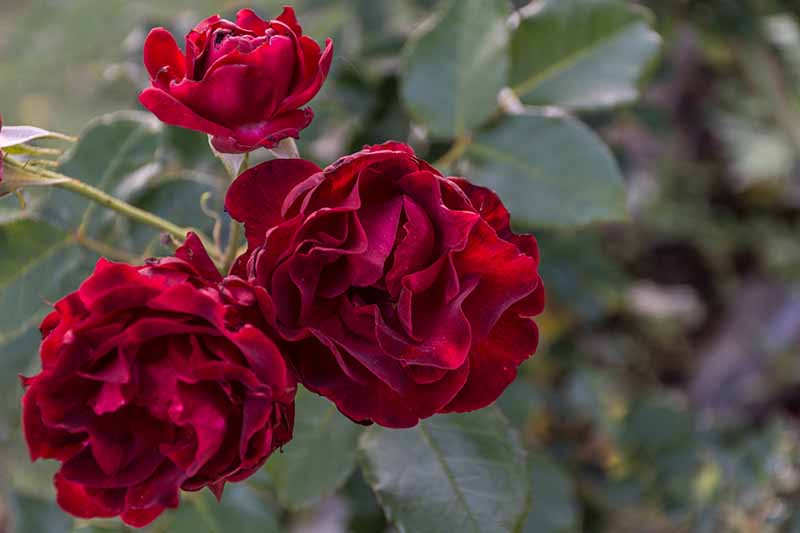
If your rose was grafted onto ‘Dr. Huey’ roots, you’ll need to be even more diligent. Commercial growers love ‘Dr. Huey’ because the roots grow so fast and healthily, but aggressive roots come at a price down the road.
It has become a bit of a running competition between me and my fellow gardeners to see how many of the dark red ‘Dr. Huey’ flowers we can spot out in the world.
They’re everywhere! No doubt, a majority of them started out as grafted or tree roses before that strong rootstock just took over.
To prevent this from happening, cut or tear any suckers that appear below the top graft union as soon as you see them. I prefer to gently tear the suckers off because this will take a bit of the base with it, and makes re-emergence less likely.
If suckers come out of the ground, scrape away the soil and trim or rip each sucker out at the base. Then refill the soil and tamp it down.
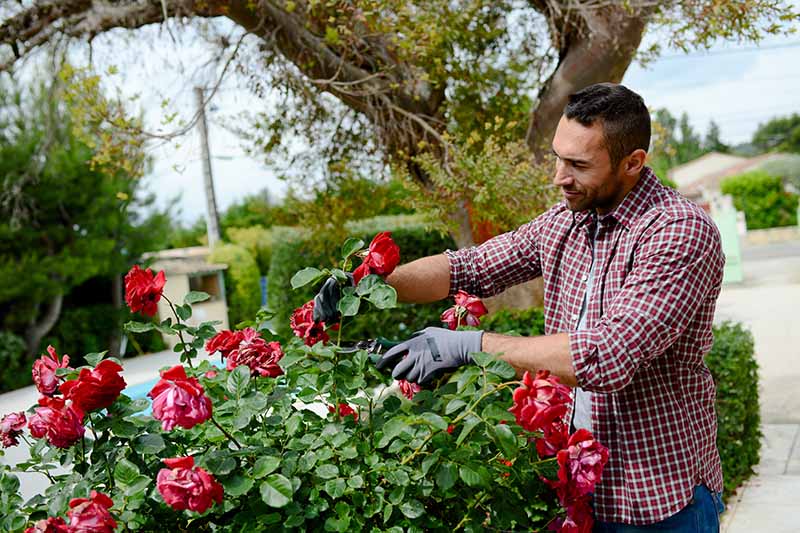
Pruning technique depends on the look you’re going for. If you want to maintain a compact, topiary shape, trim for shape in the late winter before shoots emerge.
Then, maintain the shape during the summer through deadheading and by removing any branches that are extremely long. Don’t do any major pruning in the summer.
You can learn more about how to prune roses in our guide.
Otherwise, if you want a more natural shape, prune it as you would a shrub rose. That means removing any dead, weak, or diseased canes as you see them.
In the late winter, remove about a third of the length (depending on the type) and any canes that are crossing or rubbing.
Winter Care
During the winter, standards need a little extra protection. You can heap pine boughs around the stems, or wrap the top and stem in burlap. If you live in a particularly cold zone, do both.

In colder zones, such as Zone 6 and below, you might want to prune the head back by half to reduce the chance of frost damage or breakage under the weight of heavy snow accumulation.
If you garden somewhere that reaches below 0°F in the winter and you’re determined to grow a tree rose, either plant in a container so you can move it indoors, or dig up the plant each winter.
Bury the whole thing in a trench a foot deep, and cover the trench with mulch or pine boughs.
Learn more about how to winterize roses in our guide.
Recommended Types
Tending these types takes commitment. There’s pruning, staking, winter protection, and other types of care. Don’t plant one unless you’re ready for the work.
That said, if you want a standard that is a little less delicate and high maintenance, there are some excellent options out there.

I’ve always had the best luck with standards that have a wild rose scion. Wild rose flowers are smaller so they are less heavy than a hybrid tea or floribunda. Sometimes the larger, heavier flowers can cause the stem to tilt, fall over, or break.
On the other hand, there’s no denying that a big, bountiful floribunda makes a much more striking statement in the garden.
Here are some varieties that are known to be sturdier and healthier than others.
If you’re looking for a weeping tree, ‘Renae’ is an excellent option. It’s hardy, thornless, fragrant, and has graceful weeping branches topped with small, semi-double, light pink blossoms.
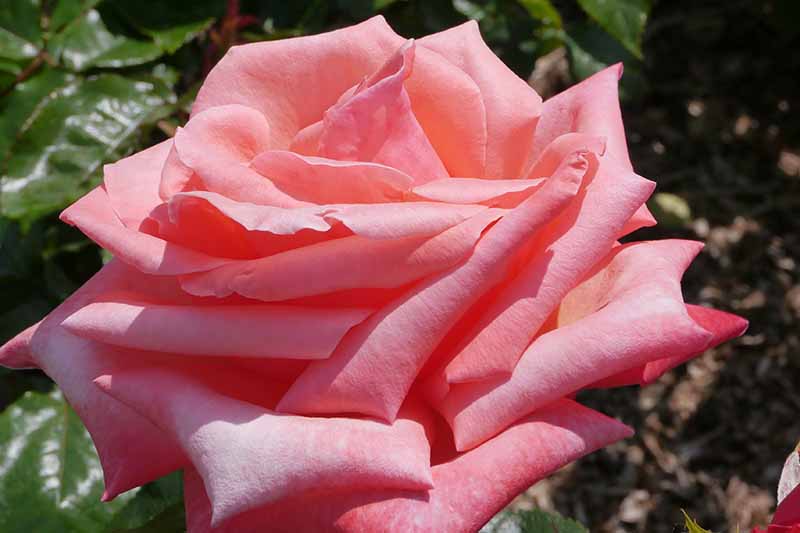
‘Silver Jubilee’ has large, full, double blossoms that are highly fragrant.
‘Blessings’ is a hybrid tea with salmon pink flowers that are large and repeat flowering.
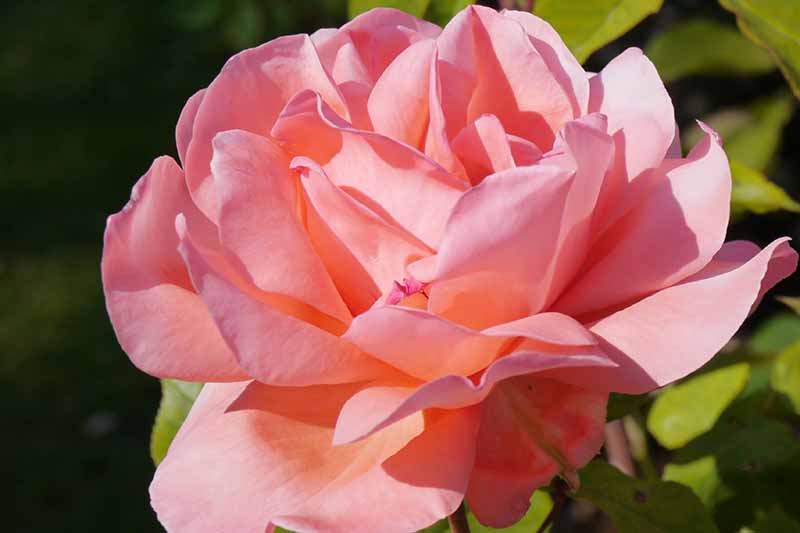
‘Olivia Rose Austin’ is pest and disease-resistant, with stunning cupped, pink, double flowers.

Knock Out®, a series known for their easy-care plants, has standards in red, pink, and yellow.
You can find Knock Out standards with red double flowers available from Perfect Plants Nursery.
Remember how tree roses are made through the process of grafting? ‘Polar Joy’ is an exception. This plant is “own root,” which means it isn’t grafted. It is trained into a tree shape rather than grafted.
It was also bred to be exceptionally winter hardy and disease resistant. Because it is own root, you don’t have to worry about suckers.
The blossoms are small and pink with subtle yellow centers.
Nature Hills Nursery carries this incredible type so you can add it to your garden.
Best Uses
Because they are tall and have a distinct shape, tree roses make an excellent focal point in the garden. You can also plant them along a walkway or fence line to create a border.

I’ve seen them used as a centerpiece for a round walkway in a garden, or planted in the middle of an area of low-growing groundcover. The latter can really make an impressive impact.
They are also perfect for container growing. They’re particularly pretty with some sort of crawling plant at the base, such as petunias, fuchsia, sweet potato vine, or creeping Jenny.
Depending on the size of the plant, you’ll need a container with a capacity that is anywhere from five to 15 gallons. Just remember that whatever planter you choose needs to be heavy enough to stay upright, even in heavy wind. And don’t forget to stake!
Tree Roses Make a Huge Impact
For such small plants, tree roses sure do make a big impact in the garden. Just one can act as a centerpiece that will draw everyone’s eye. A whole row of them makes even more of an impression!

Not so impressive? A standard that is tilted, covered in suckers, and overgrown. But that won’t be a problem for you, now that you’re armed with all the knowledge you need to succeed.
Let me know what kind you end up with in the comments section below – and feel free to share a picture!
I hope that this guide gave you the confidence to get your gorgeous new additions in the ground. If so, you might want to check out some of our other rose guides next:

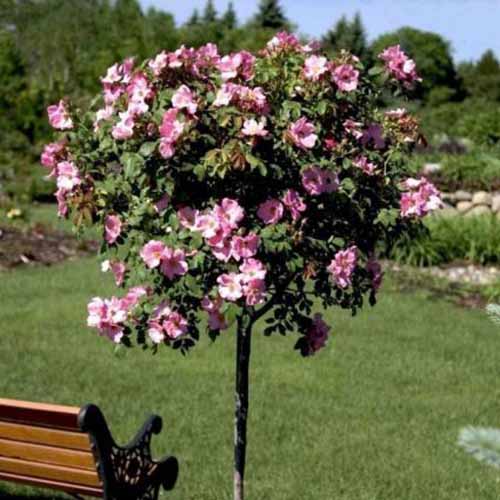



I have a tree rose in a container. Having trouble getting stakes that stay upright. What do you suggest?
I’ve run into that problem many times since potting soil can be very loose. The best options I’ve found are to either lash the stake to the side of the container or to a second stake dug into the ground next to the container. The other option is to use an obelisk or grow-through support. These tend to be a bit more balanced.
What about rebar? You could drill a hole in the container and hammer the 4’ rebar into the ground through the hole in the container for sturdy support.
Absolutely! That’s another option and thanks for sharing.
Live in Omaha, NE. Three Tree Roses
In pots. They are 3-5′ tall. Am I better to plant them in the ground or leave them in pots and store in garage for winter?
Hi Anna! You’ll be fine either way, though I prefer to keep my plants in their containers rather than move them back and forth from soil to containers. Moving them twice a year stunts their growth. If you decide to move them to the garage, wrap the pot with blankets and add a few inches of organic mulch like compost or shredded bark to the soil surface. You want to really protect those roots. If you decide to move them into the ground, wait until the leaves have fallen off and the plant is dormant, if you can. More important,… Read more »
I have had 2 tree roses for several years. We had a particularly cold spell this year. Suckers are growing like crazy off the main stem base, but not roses or growth in the original stem. What do I do? Dig them up and get new ones or will they come back? Help!
Hi Diana, it’s possible that the main stem was killed or damaged by the cold. If there are green leaves but no new growth or flowers in the crown, it probably just needs a year to recover. If there are no live leaves, slice into the outer part of a stem in the crown using a sharp knife and look for green growth. If it’s there, the plant is still alive and will recover. If the stem is brown on the inside, it’s probably dead. If that’s the case, you should dig them up. Since the roots are clearly still… Read more »
Hi, how to convert into a tree a healthy bush of roses standing on solid thick multi branches please?
Hi Nayla, if you want to turn a tree rose into a shrub, wait until the fall if you live in USDA Hardiness Zones 6 and below or the early spring just as new growth is emerging in Zones 7 and up. Trim off the entire top of the tree, taking the cane down to about a foot tall. The plant will start sending up new canes from the base. You could also wait for the plant to send up canes organically without trimming the top. Preserve these rather than trimming them off and your plant will eventually, over several… Read more »
Just wondering how to thicken up the standard rose . Mine seems a bit straggly